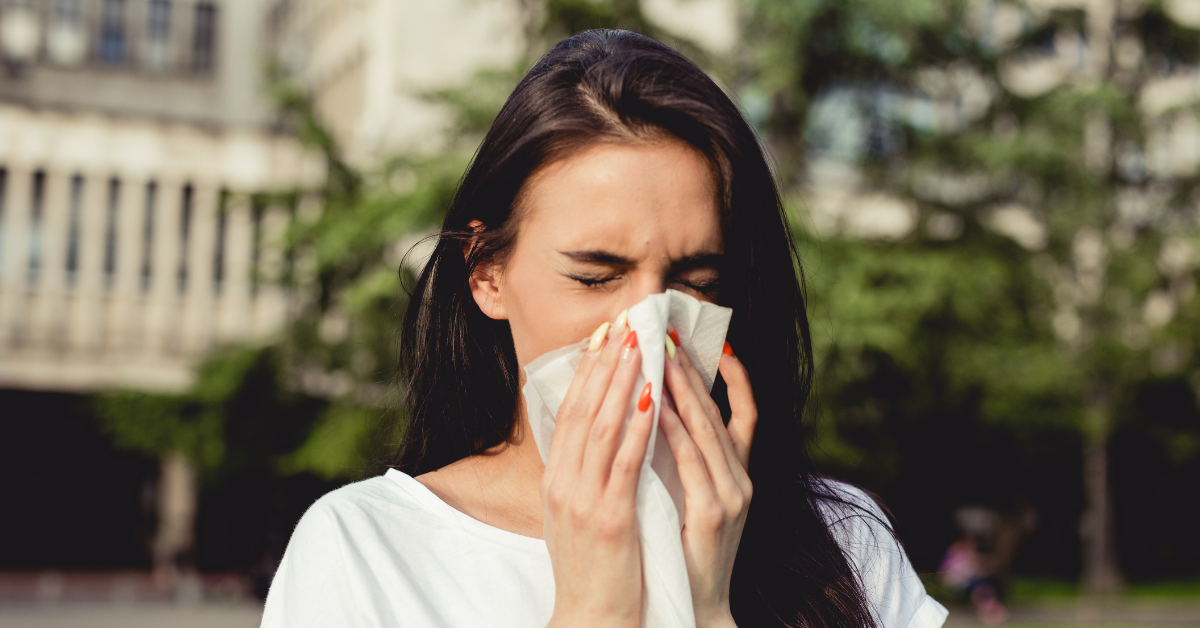Allergies, which include episodes of sneezing, stuffy nose, and a runny nose, are a worldwide health issue affecting an estimated 400 million individuals globally. These symptoms—e.g., sneezing, congestion, and itching—reflect hypersensitive immune reactions to normally harmless materials. Although contemporary medicine includes medications such as anti-allergics, antihistamines, and steroids in its protocol to treat symptoms, they are not necessarily all effective in eliminating the disease or in avoiding recurrence and may be accompanied by side effects. Ayurveda has a comprehensive view, considering such reactions as a result of internal imbalances caused by Agantuja Nidana (external stimuli). It aims to find the causes, improve digestion, and enhance immunity for successful, long-term control. As World Allergy Week 2025 (June 29–July 5) approaches, let’s discuss what is meant by ‘allergy’. How to cure allergies?, Different types of allergies, home remedies for allergies, and allergy treatment at home in this blog.

What is Meant by Allergy?
When the body hypersensitively responds to foreign proteins or antigens and presents with diverse symptoms, then allergy manifests. “Allergy” is not a term used in Ayurveda, but is explained by concepts such as Asatmya and Viruddha. Asatmya is an activity that is incompatible with one’s body or mind, and Viruddha Ahara is an unhealthy diet that causes an imbalance in body tissues. One of the main principles of the Ayurveda perception of allergy is the creation of Ama (toxins) generated by a low digestive fire, which vitiates the 3 Doshas (Vata, Pitta, and Kapha). Compromised immunity and lowered tolerance to unfavourable conditions are also among the causes of allergic reactions. The theory of Dushivisha explains that weaker toxins, which are latent in the body become effective under certain conditions. This Dushivisha concept also fits into the concept of allergies.
Different Types of Allergies
Contemporary medicine generally divides allergic reactions into two broad categories: seasonal allergies and perennial allergic reactions. Seasonal allergies will generally occur during a particular season because of allergens such as pollen, while perennial allergies are present throughout the year due to exposure to allergens like animal fur, moulds, house dust, cosmetics, and some foods.
Ayurveda literature records conditions that highly resemble all forms of allergic presentation. Pratishyaya is a Nasagata roga that is strongly associated with allergic rhinitis. It is categorised into five types according to the leading dosha: Vataja, Pittaja, Kaphaja, Raktaja, and Sannipataja (all three Doshas). Sannipataja Pratishyaya, which is clinically very similar to allergic rhinitis, has symptoms of all Doshas and may aggravate or reduce without any obvious cause, with severe pain and discomfort, sneezing, dryness, nasal fullness, head heaviness, and fever. The texts indicate that Vataja Pratishyaya can be equated with acute allergic rhinitis or seasonal allergy, whereas Sannipatika Pratishyaya is the chronic type with recurrent attacks, due to poor control of Vataja Pratishyaya. This may result in chronic mucosal thickening and raised, thickened secretions, which are similar to perennial allergic rhinitis. Beyond nasal allergies, other conditions in Ayurveda that correlate with allergies include Tamaka shwasa (asthma), Udarda, Kotha, Shitapitta (urticaria), Vicharchika (atopic dermatitis or eczema), Abhishyanda (conjunctivitis), Kandu (itching), and various skin rashes.
Home Remedies for Allergies
Allergy treatment at home includes lifestyle and dietary changes along with a few routine measures. Ayurveda focuses on balance restoration by treating the cause, strengthening immunity and digestion, and purifying the body. Various effective measures can be undertaken at home as part of a complete treatment regimen.
Dietary Modifications and Evading Unwholesome Foods
A fundamental principle of Ayurveda allergy control is evading Ahita (unwholesome) and Viruddha (incompatible) food combinations, as they derange Agni (digestive fire) and cause the production of Ama (toxins), a main cause of allergic reactions.
- Examples include mixtures such as fish with milk or honey and ghee in equal amounts, which are thought to hamper digestion and vitiate blood, possibly clogging circulatory channels and leading to a host of diseases.
Contemporary science confirms this, demonstrating that combining opposing macronutrients inhibits enzyme action and induces fermentation, gas, and inflammation.
- Seasonal food mismatches, for example, eating cold foods during winter or hot and spicy foods during summer, can exacerbate doshas and lead to gut malfunction.
- Ayurveda recommends avoiding Kapha-aggravating, mucus-producing foods such as excessive dairy, sugar, and gluten-containing grains, which are associated with increased mucus and inflammatory reactions in contemporary studies.
- Avoid consuming peanuts, milk, curd, brinjal, and pumpkin, which are proven allergens in certain individuals.
- Know your triggers and avoid consuming them.
Fresh and warm food is typically recommended.
Enhancing Digestion and Removing Ama
As Mandagni (low digestive fire) is one of the major reasons for the creation of Ama, enhancing digestive power is essential for preventing allergies. This requires not just avoiding incompatible diets and improper dietetics but also simple measures such as taking warm or hot water to aid digestion.
- Drinking warm milk or water with a pinch of turmeric can reduce episodes of sneezing and can act as an anti-allergen.
- Having one to two glasses of decoction of jeera or ginger along with pepper post-meal can enhance digestion, reduce mucus and prevent allergy.
Nasal Care (Nasya and Steam Inhalation)
For allergic rhinitis symptoms, different nasal care products are effective.
- Nasya therapy is defined as putting medicated oils or other fluids in the nostrils. In acute cases, nasal drops made with oils boiled with bitter and pungent drugs are recommended.
- Saltwater nasal rinses can also be used for symptomatic relief under proper guidance.
- Steam inhalation is also a very basic yet efficient home remedy for allergies, such as nasal congestion and the removal of mucus.
Gargling with certain medications or salt solutions can also relieve symptoms in the throat and nasal passages.
Lifestyle and Mental Health
Ayurveda recognises the direct influence of lifestyle and mental health on health and immunity.
- Getting enough sleep and exercising regularly are regarded as essential for general well-being and enhancing immunity.
- Stress management and anxiety reduction are also essential, as stress stimuli can affect immune reactions and make allergic disorders worse.
- Maintaining a log of individual triggers and also becoming more body-conscious is essential.
- Fumigation with anti-allergic herbs (neem, tulsi, turmeric) can prevent the trigger.
Wearing masks to prevent the entry of pollens, dust etc through the nose.
Adding Herbs and Supplements (under guidance)
Certain dietary changes and natural supplements help augment the body’s capacity to control allergic reactions. Adding foods that are rich in vitamin C—like seasonal fruits—can improve immunity. Correcting deficiencies in vital nutrients such as vitamins B12, D, and A is also important.
Ayurveda treatments can involve classical preparations and detoxification therapies, which are usually tailored according to specific requirements. Sophisticated interventions such as Panchakarma—more specifically, Vamana (therapeutic emesis) and Nasya (nasal application of medicated oils)—are said to facilitate allergy control but must always be performed under the supervision of an expert Ayurveda practitioner.
How To Cure Allergies?
Ayurveda aims at the prevention of the recurrence of diseases and maintenance through strengthening the internal defence mechanisms of the body and removing the causes of imbalance at its core. It encompasses an overall treatment of allergies in the form of changes in diet, lifestyle, digestion, detoxification therapy, and herbal formulations. The individualistic process can involve a longer duration of treatment for chronic diseases such as chronic rhinitis. Ayurveda therapy constructs the body’s strength to avoid hyper-reactive situations, and through the implementation of suitable therapy depending on the stage of disease and symptoms, the progression of the disease can be properly controlled.







